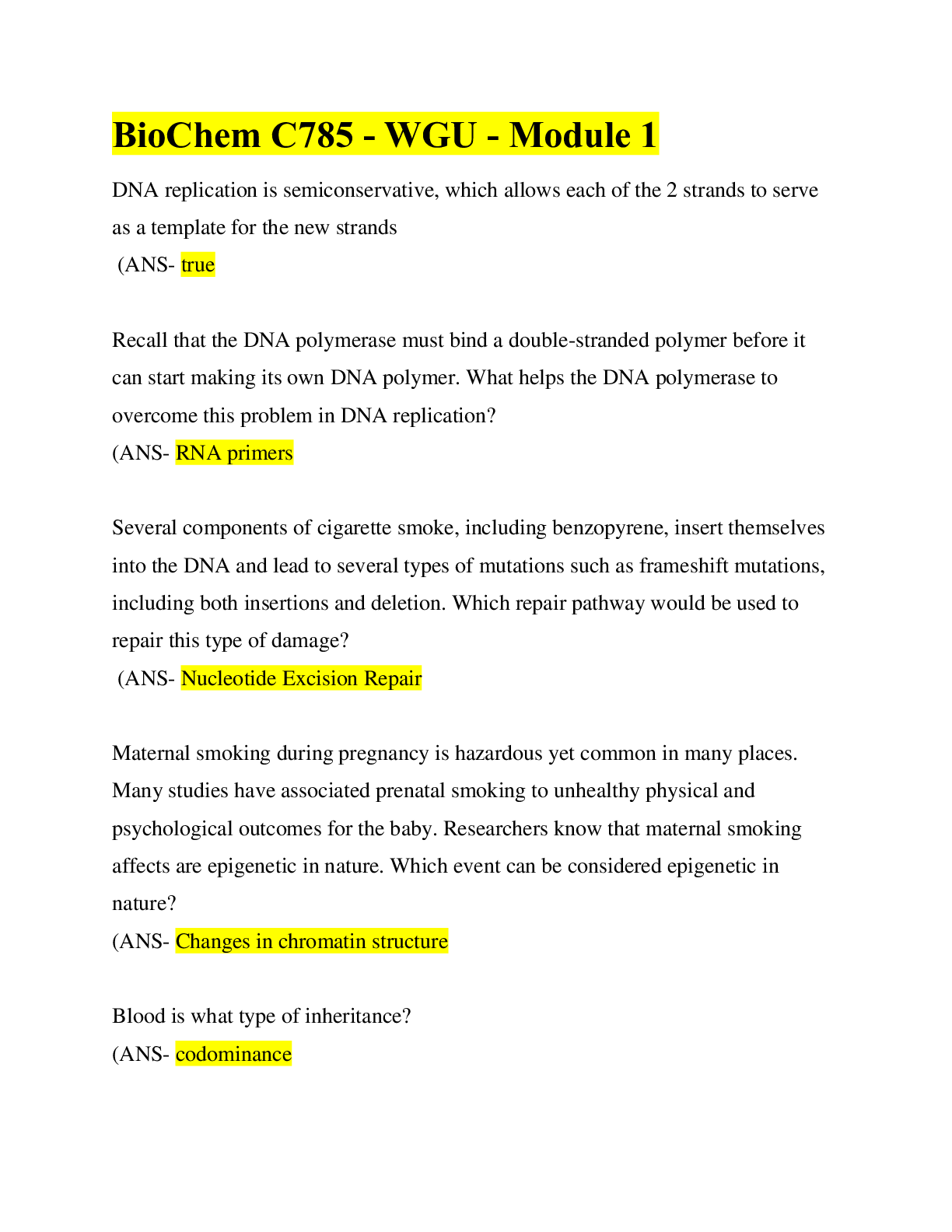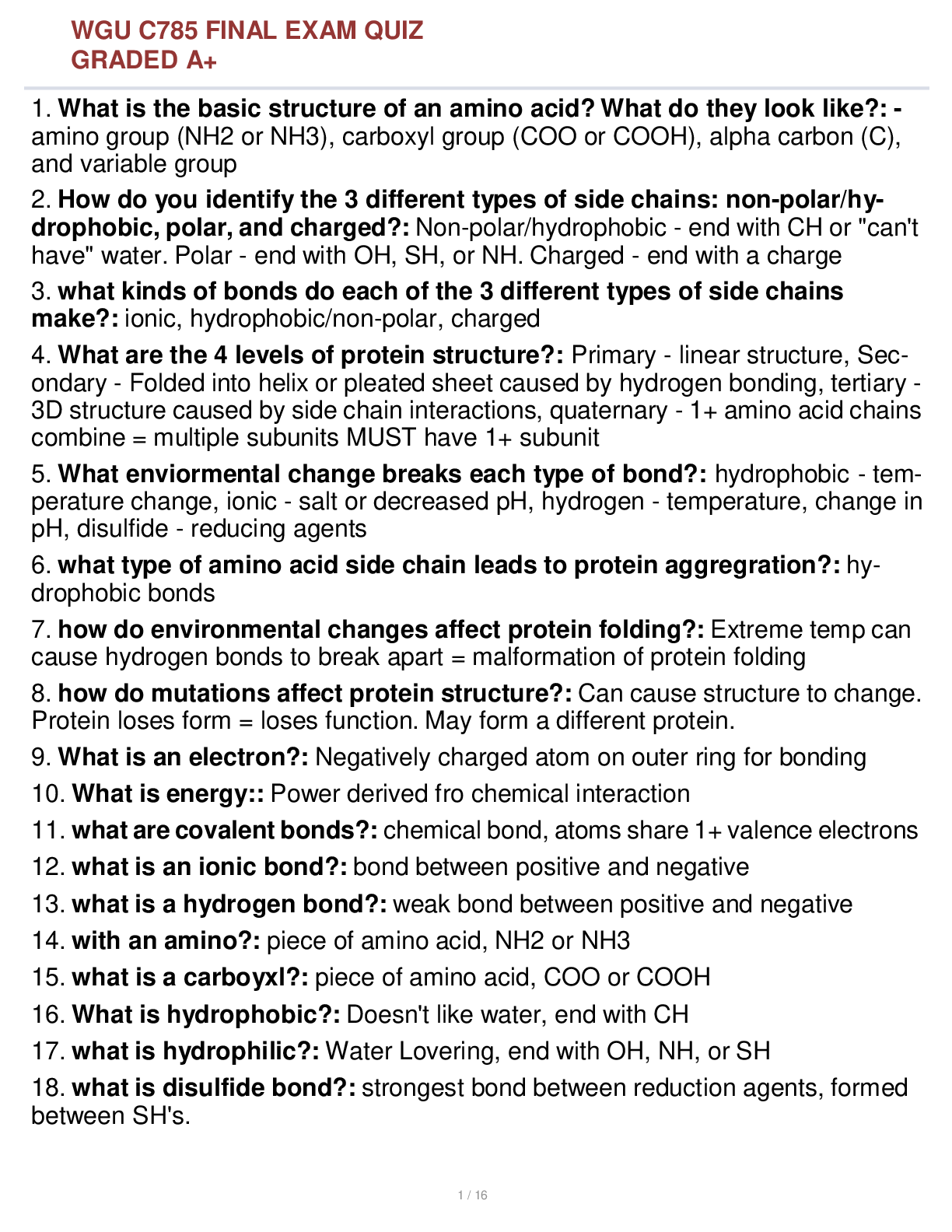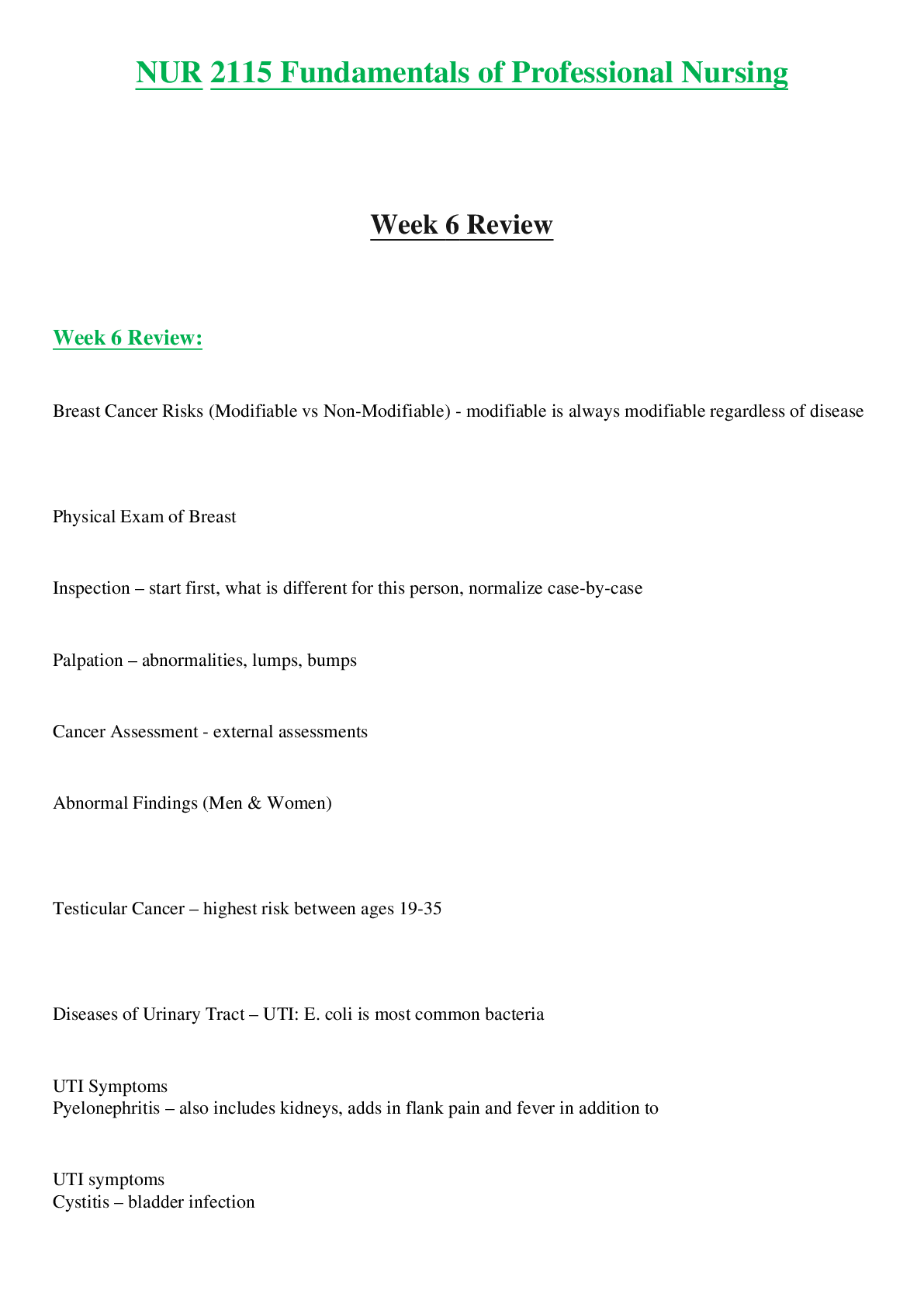Biology > STUDY GUIDE > Final BIO - Review for Midterm 1 Review for Midterm 1 University Athabasca University (All)
Final BIO - Review for Midterm 1 Review for Midterm 1 University Athabasca University
Document Content and Description Below
I found your quiz to be correctly marked and please find below the main topics that you may consider for review: 1. You may review the definitions, similarities and dissimilarities of a negative an ... d a positive feedback loops…and based on these principles you may think aboutwhere quite a few positive feedback loops (such as a the initiation and transmission of nerve impulses (action potentials), child birth/release of oxytocin and alsoblood clotting) are categorized. If the response enhances or intensifies the stimulus, a system is operating by positive feedback. If the response reverses the stimulus, a system is operating by negative feedback. 2. See the definition of the anatomical position. Then, you may need to review the anatomical positions and planes ( frontal, transverse, sagittal and oblique etc..). Planes and SecYou will also study parts of the body relative to planes, imaginary flat surfaces that pass through the body parts (Figure 1.7). A sagittal plane (SAJ-i-tal; sagitt- = arrow) is a vertical plane that divides the body or an organ Downloaded by Ian Mbogo ([email protected]) lOMoARcPSD|7822105 into right and left sides. More specifically, when such a plane passes through the midline of the body or an organ and divides it into equal right and left sides, it is called a midsagittal plane or a median plane. The midline is an imaginary vertical line that divides the body into equal left and right sides. If the sagittal plane does not pass through the midline but instead divides the body or an organ into unequal right and left sides, it is called a parasagittal plane (para- = near). A frontal or coronal plane (kō-RŌ-nal; corona = crown) divides the body or an organ into anterior (front) and posterior (back) portions. A transverse plane divides the body or an organ into superior (upper) and inferior (lower) portions. Other names for a transverse plane are a crosssectional or horizontal plane. Sagittal, frontal, and transverse planes are all at right angles to one another. An oblique plane (ō-BLĒK), by contrast, passes through the body or an organ at an oblique angle (any angle other than a 90-degree angle). 3. See the definitions of the most important life processes and the basic features of each of the basic life processes of the human body. Basic Life Processes Certain processes distinguish organisms, or living things, from nonliving things. Following are the six most important life processes of the human body: 1. Metabolism (me-TAB-ō-lizm) is the sum of all chemical processes that occur in the body. One phase of metabolism is catabolism (ka-TAB-ō-lizm; catabol- = throwing down; -ism = a condition), the breakdown of complex chemical substances into simpler components. The other phase of metabolism is anabolism (a-NAB-ō-lizm; anabol- = a raising up), the building up of complex chemical substances from smaller, simpler components. For example, digestive processes catabolize (split) proteins in food into amino acids. These amino acids are then used to anabolize (build) new proteins that make up body structures such as muscles and bones. 2. Responsiveness is the body's ability to detect and respond to changes. For example, an increase in body temperature during a fever represents a change in the internal environment (within the body), and turning your head toward the sound of squealing brakes is a response to a change in the external environment (outside the body) to prepare the body for a potential threat. Different cells in the body respond to environmental changes in characteristic ways. Nerve cells respond by generating electrical signals known as nerve impulses (action potentials). Muscle cells respond by contracting, which generates force to move body parts. 3. Movement includes motion of the whole body, individual organs, single cells, and even tiny structures inside cells. For example, the coordinated action of leg muscles moves your whole body from one place to another when you walk or run. After you eat a meal that contains fats, your gallbladder contracts and releases bile into the gastrointestinal tract to help digest them. When a body tissue is damaged or infected, certain white blood cells move from the bloodstream into the affected tissue to help clean up and repair the area. Inside the cell, various parts, such as secretory vesicles (see Figure 3.20), move from one position to another to carry out their functions. Downloaded by Ian Mbogo ([email protected]) lOMoARcPSD|7822105 4. Growth is an increase in body size that results from an increase in the size of existing cells, an increase in the number of cells, or both. In addition, a tissue sometimes increases in size because the amount of material between cells increases. In a growing bone, for example, mineral deposits accumulate between bone cells, causing the bone to grow in length and width. 5. Differentiation (dif′-er-en-shē-Ā-shun) is the development of a cell from an unspecialized to a specialized state. Such precursor cells, which can divide and give rise to cells that undergo differentiation, are known as stem cells. As you will see later in the text, each type of cell in the body has a specialized structure or function that differs from that of its precursor (ancestor) cells. For example, red blood cells and several types of white blood cells all arise from the same unspecialized precursor cells in red bone marrow. Also through differentiation, a single fertilized human egg (ovum) develops into an embryo, and then into a fetus, an infant, a child, and finally an adult. 6. Reproduction (rē-prō-DUK-shun) refers either to (1) the formation of new cells for tissue growth, repair, or replacement, or (2) the production of a new individual. The formation of new cells occurs through cell division. The production of a new individual occurs through the fertilization of an ovum by a sperm cell to form a zygote, followed by repeated cell divisions and the differentiation of these cells. When any one of the life processes ceases to occur properly, the result is death of cells and tissues, which may lead to death of the organism. Clinically, loss of the heartbeat, absence of spontaneous breathing, and loss of brain functions indicate death in the human body. 4. You may need to see the definitions of isotonic, hypotonic, and hypertonic solutions and also distinguish among isotonic, hypotonic, and hypertonic solutions …..alsohow water moves from one type of solutionto anotherand how above solutions are used in a few health situations.See also p. 68on how the above solutions areused in a few health situations. Medical Uses of Isotonic, Hypertonic, and Hypotonic Solutions RBCs and other body cells may be damaged or destroyed if exposed to hypertonic or hypotonic solutions. For this reason, most intravenous (IV) solutions, liquids infused into the blood of a vein, are isotonic. Examples are isotonic saline (0.9% NaCl) and D5W, which stands for dextrose 5% in water. Sometimes infusion of a hypertonic solution such as mannitol (sugar alcohol) is useful to treat patients who have cerebral edema, excess interstitial fluid in the brain. Infusion of such a solution relieves fluid overload by causing osmosis of water from interstitial fluid into the blood. The kidneys then excrete the excess water from the blood into the urine. Hypotonic solutions, given either orally or through an IV, can be used to treat people who are dehydrated. The water in the hypotonic solution moves Downloaded by Ian Mbogo ([email protected]) lOMoARcPSD|7822105 from the blood into interstitial fluid and then into body cells to rehydrate them. Water and most sports drinks that you consume to “rehydrate” after a workout are hypotonic relative to your body cells. 5. Cell division of the somatic cells; the phases of somatic cell division; reviewthe main events occurring in each phaseandmore specifically see what happens in interphase. 6. Main features of simple and stratified cuboidal epithelium (see where these two types of epitheliumaremostly found in the body; table 4.1 may help. A. SIMPLE SQUAMOUS EPITHELIUM Description Simple squamous epithelium is a single layer of flat cells that resembles a tiled floor when viewed from apical surface; centrally located nucleus that is flattened and oval or spherical in shape. Location Most commonly (1) lines the cardiovascular and lymphatic system (heart, blood [Show More]
Last updated: 3 years ago
Preview 1 out of 50 pages

Buy this document to get the full access instantly
Instant Download Access after purchase
Buy NowInstant download
We Accept:

Reviews( 0 )
$10.50
Can't find what you want? Try our AI powered Search
Document information
Connected school, study & course
About the document
Uploaded On
Aug 12, 2021
Number of pages
50
Written in
All
Additional information
This document has been written for:
Uploaded
Aug 12, 2021
Downloads
0
Views
178










.png)
.png)













